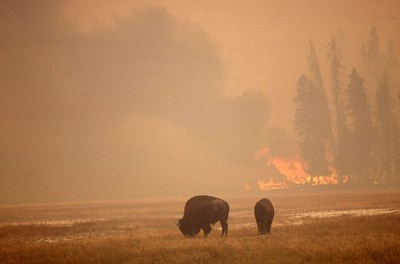Last updated: November 2, 2017
Article
Bison Bellows: Mass Moralities of Bison

Photo courtesy of Jeff Henry/NPS Photo
As morbid as the title sounds, natural mass mortalities among bison are not as uncommon as you would think. Today, the frequency of such events is much lower compared to pre-European settlement---due to human management---but mass mortalities can and do occur. Today, weather and natural disasters contribute to the most common causes for multiple individual deaths. Indeed, the bison's gregarious behavior also influences the number of mortalities.
When people hear "mass animal deaths," one may think of the (inaccurate) myth depicting lemmings jumping off a cliff in a mass suicide event. While this is not the case for bison (unless you consider indigenous hunting practices by means of buffalo jumps), their social and aggregate traveling behavior can influence the large numbers of deaths occasionally seen. When bison travel, they typically form a narrow line in a follow-the-leader type of fashion, particularly when untrammeled winter snows impose high energetic costs to bison venturing off packed trails. To add to the issue, bison can run up to 35 mph. If these two aspects are combined, it would be extremely difficult for a large herd running at top speed to stop quickly before reaching eminent danger, for one would run right into the next. There is record that in 1867, a herd of 4,000 bison attempted to cross the Platte River in Nebraska and ran into loose quicksand near the river, one right after the other because they were simply following the herd.
Droughts, thin ice, wildfires, and natural disasters can all trigger a mass mortality event as well. There are reports of drowning incidents of entire herds when bison accidently fall through thin ice during the spring and fall months. Fire can also influence more than a single individual death. Bison, like many large mammals, are very adept at moving away from wildfires. However, if a fire changes direction too quickly or moves faster than animals may anticipate, wildfires can catch bison and other wildlife off guard and entrap them in an inescapable situation. For example, it is estimated that roughly 300 large mammals perished as a direct result of the 1988 Yellowstone Fire, nine of which were bison.
At a larger scale as the climate is changing, it will be important for bison conservation herd managers to consider the rate at which mass mortalities occur. Will warmer winter temperatures translate to thinner ice, increasing the potential for whole herds to fall though? Will there be more wildfires and drought periods due to drier climates? These questions are important for biologists and stakeholders to consider in long-term management plans aimed at the ongoing conservation and restoration strategies for bison as a species. Fortunately, such events do not tend to occur at the same time across the large geographic range where bison conservation herds reside today. However, such events can have significant impacts to individual herds, especially if the surviving population is small and isolated from other bison.
